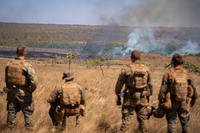Would you believe it if someone told you the Coast Guard was in Minneapolis, Minn., or Omaha, Neb.? As a matter of fact, the Coast Guard has units in both places and many others in the upper Midwest region. Their work may be local, but the missions they perform have a global effect.
Coast Guard Sector Upper Mississippi River in St. Louis is the parent command of the three marine safety detachments and five river buoy tenders who call the river home. These units operate in a vast area from the upper Mississippi to the Illinois and Missouri rivers. While their jobs are not the most well-known in the Coast Guard, they are no less important.
In fact, the agricultural products and the agribusiness industry in the Mississippi River basin produces 92 percent of the nation’s agricultural exports, 78 percent of the world’s exports in feed grains and soybeans and most of the livestock and hogs produced nationally. Sixty percent of all grain exported from the U.S. is shipped on the Mississippi River. The Mississippi and other rivers are also used to transport energy goods such as crude oil, petroleum and coal. Making sure the rivers are safe for the navigation of large barges carrying all these goods is what makes the Coast Guard river buoy tenders so vital.
Ensuring safety on these waterways is a small fleet of river tenders. There are only five – Cheyenne, Gasconade, Wyaconda, Sangamon and Scioto – but they operate on miles upon miles of waterways. Each river tender’s crew is responsible for a portion of river totaling 3,000 miles of commercially navigable waterways.
“The nation and world’s economies rely on the western rivers to move grain and other vital commodities. We ensure they arrive safely from port to port. Without the Coast Guard on the river, that would not be possible,” said Master Chief Petty Officer Arthur Ford, officer-in-charge of Scioto.
The tenders mark navigable channels in the river, which continuously change from drought and flooding through the year. This is done by either setting buoys to mark the changing channel or by maintaining day beacons, which are permanent fixtures. Each river is unique and they aren’t marked exactly the same.
"The Mississippi is much wider and used much more often. The Missouri is faster and much narrower,” said Ford. “They are both easy to mark and have similarities, but the Missouri uses jet cones to hold buoys in place and that takes a little more time to do. On [the] Missouri you rely more on shore aids than buoys.”
While the safety of transiting on the river is the river tender’s concern, the safety of who and what is traveling the river is the marine safety detachments concern.
The three detachments in the northern Midwest are responsible for inspections and investigations of commercial vessels and facilities on or along the major rivers. These include passenger vessels and terminals, barges and their tow and mobile transfer facilities. According to Lt. Cmdr. Chris Tantillo, chief of inspections for Sector Upper Mississippi River, members are looking to make sure passenger or industry vessels are seaworthy and safe for people and the environment. The detachments also inspect about 98 facilities for safety and environmental integrity.
The Coast Guard’s role in the Midwest often goes unnoticed but is no less important than the role of those who operate offshore. By keeping the rivers open, units in the in the upper Midwest region keep commerce open.






















